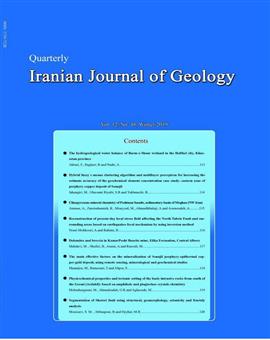Reconstruction of present-day local stress field affecting the North Tabriz Fault and surrounding areas based on earthquakes focal mechanism by using inversion method
Subject Areas :Ahad Noori 1 , Behnam Rahimi 2
1 - Ferdosi University
2 - Ferdosi University
Keywords: Stresses separation North Tabriz fault Earthquake focal mechanism, Stresses field. ,
Abstract :
In this research, present-day tectonic stress field affecting North Tabriz Fault and surrounding areas was reconstructed by using 37 compiled earthquakes focal mechanism from various sources. Triangle diagrams were used to determine the sense of the earthquakes focal mechanism. The sense of these data varies from strike-slip to thrust regime. Stress separation process was applied on data set for separation of the various tectonics regimes from a poly-phase system to obtain reduced stress tensors. This was done because most of the data participated in them and reconstructed stress fields completely cover the stresses affecting the region. The results of inversion analysis and internal separation of the data set show three stress regimes acting in this region. Considerably, all three stress regimes have a horizontal pressure stress with NW-SE to NNW-SSE trend. The direction of maximum pressure in each first, second and third regimes is 09/329, 28/310 and 03/138, respectively. In this research, present-day tectonic stress field affecting North Tabriz Fault and surrounding areas was reconstructed by using 37 compiled earthquakes focal mechanism from various sources. Triangle diagrams were used to determine the sense of the earthquakes focal mechanism. The sense of these data varies from strike-slip to thrust regime. Stress separation process was applied on data set for separation of the various tectonics regimes from a poly-phase system to obtain reduced stress tensors. This was done because most of the data participated in them and reconstructed stress fields completely cover the stresses affecting the region. The results of inversion analysis and internal separation of the data set show three stress regimes acting in this region. Considerably, all three stress regimes have a horizontal pressure stress with NW-SE to NNW-SSE trend. The direction of maximum pressure in each first, second and third regimes is 09/329, 28/310 and 03/138, respectively.
